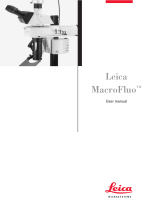Page is loading ...

Is a Magnification of 20,000 Times Really
Useful With Digital Microscopy?
Left: Taxus, cross sectioned at –120 °C, investigated in a cryo SEM
Camera chip
Eyepieces
Ant (sample)
Smaller monitor
Larger monitor
Introduction
Digital microscopes have only a camera for image observation
and no eyepieces. Microscopes with eyepieces for visual
observation, such as stereo microscopes, can also be equipped
with digital cameras. Both types of microscope are used for a
variety of technical applications in many different fields and
industries.
To evaluate the performance of an optical microscope, knowing
its highest achievable magnification is important. For digital
microscopy, very high magnification values, such as 20,000x,
are sometimes mentioned. This report provides some helpful
guidelines concerning the useful range of magnification for
digital microscopy.
Magnification defined
Magnification is defined as the ratio of the size of a feature on
an object as seen in an image to the actual size of the feature
itself. The lateral, two-dimensional magnification can be
determined from:
Magnification =
Dimension of feature in image
Dimension of feature on actual object
Examples of a digital microscope and stereo microscope with
eyepieces and digital camera are shown below.
Left: Leica M205 C stereo microscope fitted with the Leica DFC450 digital camera. The ant sample can be observed via the eyepieces or a display monitor (2 sizes shown) for image
detection by the camera.
Right: Leica DMS1000 digital microscope utilizing different monitor sizes for image display.

www.leica-microsystems.com
USEFUL RANGE OF MAGNIFICATION FOR DIGITAL MICROSCOPY
There is always the question if this level of magnification,
20,000 x, is simply beyond the useful range, meaning, is it
empty magnification where no further details are resolved?
What determines a useful range of magnification for digital
microscopy, where an image is observed via display on a
monitor? There are 2 main factors: the microscope system
resolution and the image viewing distance.
Microscope system resolution
The system resolution for a digital microscope or microscope
with eyepieces operated with a digital camera is influenced
by 3 main factors:
› Optical resolution from the objective, zoom, tube, and
camera mount lenses
› Image sensor resolution from the camera chip
› Image display resolution from the electronic monitor.
The resolution limit of the digital microscope system is
determined by the smallest of the 3 resolution values above.
Useful range of magnification
First, it is assumed that the viewing distance, the distance
between the eyes of the observer and the displayed image, is
always within the useful range. The useful range of
viewing distance is based upon a conventional reference of
25 cm, the average nearest point for the human eye where
clear focus is possible.
The useful range of magnification for digital microscopy can
be defined as:
System resolution
<
Useful
magnification
<
System resolution
6 3
Thus, the useful range of magnification is between
1
/6 and
1
/3 of the microscope system resolution.
Modern camera chips often have pixel sizes well below 10µm
and modern monitors pixel sizes well below 1 mm. At high
magnification from the sample to the camera chip, for
example 150x, then the microscope system resolution is
determined by the optical resolution limit. The optical
resolution limit for the largest numerical aperture, 1.3, and the
smallest wavelength of visible light, 400 nm, is about 5,400
line pairs/mm. The maximum magnification which falls into
the useful range defined just before is 1,800x.
At very low magnification, for example below 1x from the
sample to the camera chip, the numerical aperture is usually
quite small, however the resolution limit of camera chips with
pixel sizes larger than 2 µm and of monitors with pixel sizes
larger than 0.5 mm will normally be less than the optical
resolution. Therefore, at very low magnification, the chip or
monitor resolution limit is often the dominating factor.
Empty magnification
Whenever the magnification value exceeds the useful
magnification range for digital microscopy, 1,800x, this results
in empty magnification where the image appears bigger, but
no further details about the sample can be resolved. A
magnification of 20,000x is far beyond 1,800x, so clearly it is
empty magnification.
Conclusion
For digital microscopes, as for other optical microscopes,
there is a clear limit on the useful range of magnification.
Going beyond that magnification range, in other words
exceeding 1,800x, only results in empty magnification. To
understand the useful range of magnification for digital
microscopy in more detail, please refer to the technical report
cited below as additional reading.
Additional reading
DeRose, J.A., Doppler, M.: What Does 30,000x Magnification Really Mean? Some
Useful Guidelines for Understanding Magnification in Today’s New Digital Microscope
Era. Leica Science Lab, February 2015
Authors: J.A. DeRose, M. Doppler, Leica Microsystems
/

